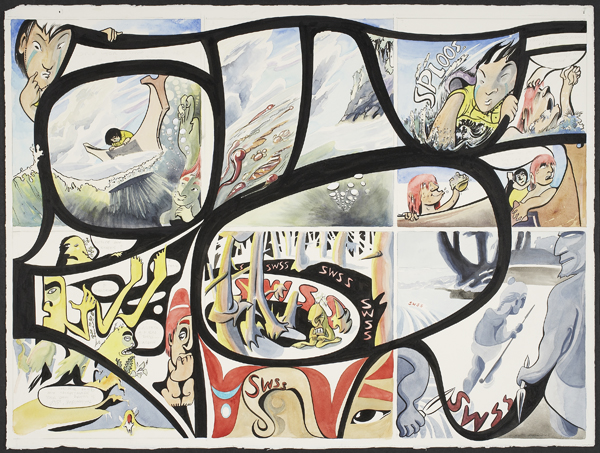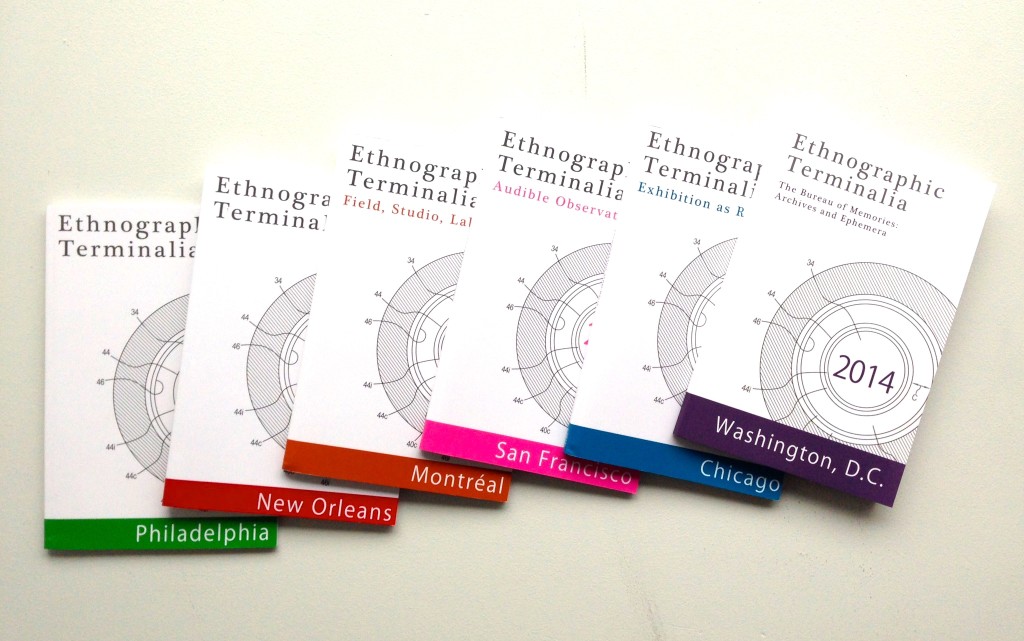SEDUCTION (2010)

Nicola Levell and Michael Nicoll Yahgulanaas
Into Haida Manga: Raven Kept on Walking
In this artwork, SEDUCTION, Raven–the inveterate trickster of North Pacific Coast indigenous mythology—makes a subversive entry into the graphic world of Haida Manga. Originated by the Haida artist, political activist and satirist, Michael Nicoll Yahgulanaas (MNY), Haida Manga refigures and fuses traditional Haida formlines and iconography with Japanese-inspired Manga to create a dynamic contemporary idiom for circulating Haida oral narratives and cautionary tales within and beyond indigenous, local and generational spheres of exchange. Exploiting Manga’s predilection for dominant black and white visuals, this Haida Manga artwork, which debuted in Tokyo, graphically narrates one particular episode, when Raven seduced and tricked a band of fishermen. The seduction of the fishermen forms part of a longer narrative, known as, ‘Raven Kept on Walking’, which in the past was narrated, within a familial setting on Haida Gwaii, over the course of 3 or 4 winter evenings. The ten graphic panels of this installation, SEDUCTION, vividly recount the arrival in a small fishing community of the trickster Raven, who appears in stereotypical transgendered guise. A heavily made-up, long-lashed cross-dresser, s/he becomes the first hooker and seduces the fishermen. In the mornings, while the fishermen recover from their evenings of debauchery, Raven goes fishing and greedily steals away their livelihoods and means of subsistence. With determination and irresistible bait, the fishermen set out to capture the Trickster that dives so deep and deprives them of their catch. Because of the depth of its dive, they mistakenly believe their adversary is a shark, rather than their age-old feathered foe. When they hook their prey, there is such resistance on the line, which seems to confirm their belief: the glutton is a big fish. But it is the gluttonous Raven, who being hooked through the beak, desperately holds on to a rock. The fishermen continue to pull and Raven painfully loses his upper jaw. To regain his hooked beak, Raven re-enters the fishing community in disguise; s/he tells them that the sea monster, whose horny jaw they possess, will insatiably feed on their innocence, bringing hunger, pain and death. So, Raven tricks them again, convincing them to run away and hide. When they do so, s/he regains the beak and consumes all their food. SEDUCTION ends, when the fishermen realize that they have been fooled or seduced once more, by the hooker they hooked.
Credit
Tech: Gillian Stokvis-Hauer
RED (2009)
This collaborative short film, profiling the artist Michael Nicoll Yahgulanaas, was created to dialogue with the remarkable 5 meter-long mural, a series of 108 painted illustrations, which form the content of his 2009 graphic novel, Red: A Haida Manga.
Credits:
Direcctor: Jon Ritchie; Camera: Rudi Kovanic; Original Score: Cris Derksen; Animation: Chris Auchter; Tech: Gillain Stovis-Hauer.
Biographies
Michael Nicoll Yahgulanaas (MNY) AKA the “Haida-Manga guy” is an artist of indigenous and European settler ancestry, who grew up on the North Pacific islands of Haida Gwaii. Before relocating to Vancouver in 2001, for over two decades, MNY held political positions on Haida Gwaii, at a time when the Haida Nation was proactively negotiating issues of land, indigenous title and rights and contesting neo-colonialist acts of environmental exploitation. During this critical period, his early artworks, especially his politically-informed satirical and humorous cartoons, were circulating locally in various print media. More recently, his development of Haida-Manga—a distinctive and dynamic artform influenced by his technical training with master craftsmen, including Chinese brush painting master, Cai Ben Kwon—has enabled him to dessiminate, largely through publication, Haida culture, indigenous issues and wider environmental concerns to a global audience. Through transculturating Haida formlines and oral histories, with manga, the Japanese genre of graphic illustration, Haida-Manga operates as a hybrid idiom or creative creole that invigorates Haida art, extending it beyond the neo-traditional media and forms that dominate the local field of production. Now, no longer restricted to the medium of paper, Haida-Manga, which has been embraced by manga aficionados in Asia and elsewhere, circulates in multimedia productions, from painted canvases, through short animations to recycled automobile parts.
Nicola Levell is an assistant professor in the Anthropology Department at the University of British Columbia (Vancouver), whose teaching and research interests are located in the interdisciplinary folds of anthropology, theoretical museology and critical curatorial studies. Before moving into academia she was a curator in London (UK). Informed by her curatorial practice, her current research is orientated to contemporary culture-making and the politics and performativity of space (material forms and social relations) on the North Pacific Coast of Canada. She is especially interested in the work of institutions, artists and curators and their role in the local/ global production and circulation of indigenous and indigenized cultural media, both concrete expressions and intangible forms.

